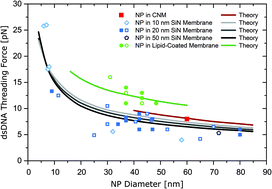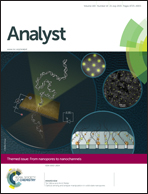Controlled translocation of DNA through nanopores in carbon nano-, silicon-nitride- and lipid-coated membranes
Abstract
We investigated experimentally and theoretically the translocation forces when a charged polymer is threaded through a solid-state nanopore and found distinct dependencies on the nanopore diameter as well as on the nano membrane material chemistry. For this purpose we utilized dedicated optical tweezers force mechanics capable of probing the insertion of negatively charged double-stranded DNA inside a helium-ion drilled nanopore. We found that both the diameter of the nanopore and the membrane material itself have significant influences on the electroosmotic flow through the nanopore and thus on the threading force. Compared to a bare silicon-nitride membrane, the threading of DNA through only 3 nm thin carbon nano membranes as well as lipid bilayer-coated nanopores increased the threading force by 15% or 85%, respectively. This finding was quantitatively described by our recently developed theoretical model that also incorporates hydrodynamic slip effects on the translocating DNA molecule and the force dependence on the membrane thickness. The additional measurements presented in this paper further support our model.

- This article is part of the themed collection: From nanopores to nanochannels

 Please wait while we load your content...
Please wait while we load your content...